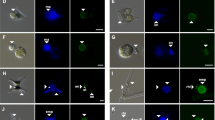Abstract
Since current protocols were found to be inadequate for the identification of bacteria pathogenic toGracilaria gracilis, an assay was developed which made use of ‘axenic’ algae in order to attribute disease symptoms directly to the presence of a specific bacterial isolate. However, this assay proved to be as unreliable as existing procedures and failed to satisfy Koch's postulates. A second pathogenicity assay was developed which proved more reliable in that each bacterial strain consistently induced a particular symptom in the infected algal thallus. The bacterial strain LS2i was identified as a possible pathogen ofG. gracilis using this assay. However, this assay did not satisfy Koch's criteria for establishing an unequivocal link between the observed disease symptoms and strain LS2i, since significant bacterial contamination of the test alga occurred. A third protocol generated consistent results and satisfied Koch's postulates, enabling the identification of six pathogens ofG. gracilis. All the pathogenic bacterial strains were agarolytic.
Similar content being viewed by others
References
Anderson RJ, Simons RH, Jarman NG (1989) Commercial seaweeds in Southern Africa: A review of utilisation and research. S. Afr. J. mar. Sci. 8: 277–289.
Anderson RJ, Levitt GJ, Keats DW, Simons RH (1993) The role of herbivores in the collapse of theGracilaria resource at Saldanha Bay, South Africa. Hydrobiologia 260/261: 285–290.
Anderson RJ, Monteiro PMS, Levitt GJ (1996) The effect of localised eutrophication on competition betweenUlva lactuca (Ulvaceae, Chlorophyta) and a commercial resource ofGracilaria verrucosa (Gracilariaceae, Rhodophyta). Hydrobiologia (in press).
Andrews JH (1976) The pathology of marine algae. Biol. Rev. 51: 211–253.
Armisen R (1995) World-wide use and importance ofGracilaria. J. appl. Phycol. 7: 231–243.
Austin B (1988) Identification. In Austin B (ed.), Methods in Aquatic Bacteriology. John Wiley and Son Ltd, Great Britain: 95–112.
Black JG (1996) Host-microbe relationships and disease processes In Microbiology: Principles and Applications, 3rd Edition. Prentice-Hall, Inc.: 397–398.
Correa JA, Craigie JS (1991) Algal pathology. In Garcia-Reina, G., Pedersén, M. (eds), Seaweed Cellular Biotechnology, Physiology and Intensive Cultivation. COST 48, Universidad de Las Palma de Gran Canaria: 67–82.
Friedlander M, Gunkel W (1992) Factors leading to thallus disintegration and the control of these factors inGracilaria sp. In Moav B, Hilge B, Rosenthal H (eds), Proceedings of the 4th German-Israeli Status Seminar. EAS special publication no 17, Oostende: 221–243.
Friedlander M, Levy I (1995) Cultivation ofGracilaria in outdoor tanks and ponds. J. appl. Phycol. 7: 315–324.
Largo DB, Jukami K, Nishijima T (1995a) Occasional pathogenic bacteria promotingice-ice disease in the carrageenan-producing red algaeKappaphycus alvarezii andEucheuma denticulatum (Solieriaceae, Gigartinales, Rhodophyta). J. appl. Phycol. 7: 545–554.
Largo DB, Fukami K, Nishijima T, Ohno M (1995b) Laboratory-induced development of theice-ice disease of the farmed red algaeKappaphycus alvarezii andEucheuma denticulatum (Solieriaceae, Gigartinales, Rhodophyta). J. appl. Phycol. 7: 539–543.
Lavilla-Pitogo CR (1992) Agar-digesting bacteria associated with ‘rotten thallus syndrome’ ofGracilaria sp. Aquaculture 102: 1–7.
McHugh DJ (1991) Worldwide distribution of commercial resources of seaweeds includingGelidium. Hydrobiologia 221: 19–29.
Uyenco FR, Saniel LS, Jacinto GS (1981) The ‘ice-ice’ problem in seaweed farming. In Levring T(ed.), Proc. Tenth Int. Seaweed Symp. Walter de Gruyter & Co., Berlin: 625–630.
Weinberger F, Friedlander M, Gunkel W (1994) A bacterial facultative parasite ofGracilaria conferta. Dis. Aquat. Org. 18: 135–141.
Author information
Authors and Affiliations
Rights and permissions
About this article
Cite this article
Jaffray, A.E., Coyne, V.E. Development of anin situ assay to detect bacterial pathogens of the red algaGracilaria gracilis (Stackhouse) Steentoft, Irvine et Farnham. J Appl Phycol 8, 409–414 (1996). https://doi.org/10.1007/BF02178585
Received:
Revised:
Accepted:
Issue Date:
DOI: https://doi.org/10.1007/BF02178585




